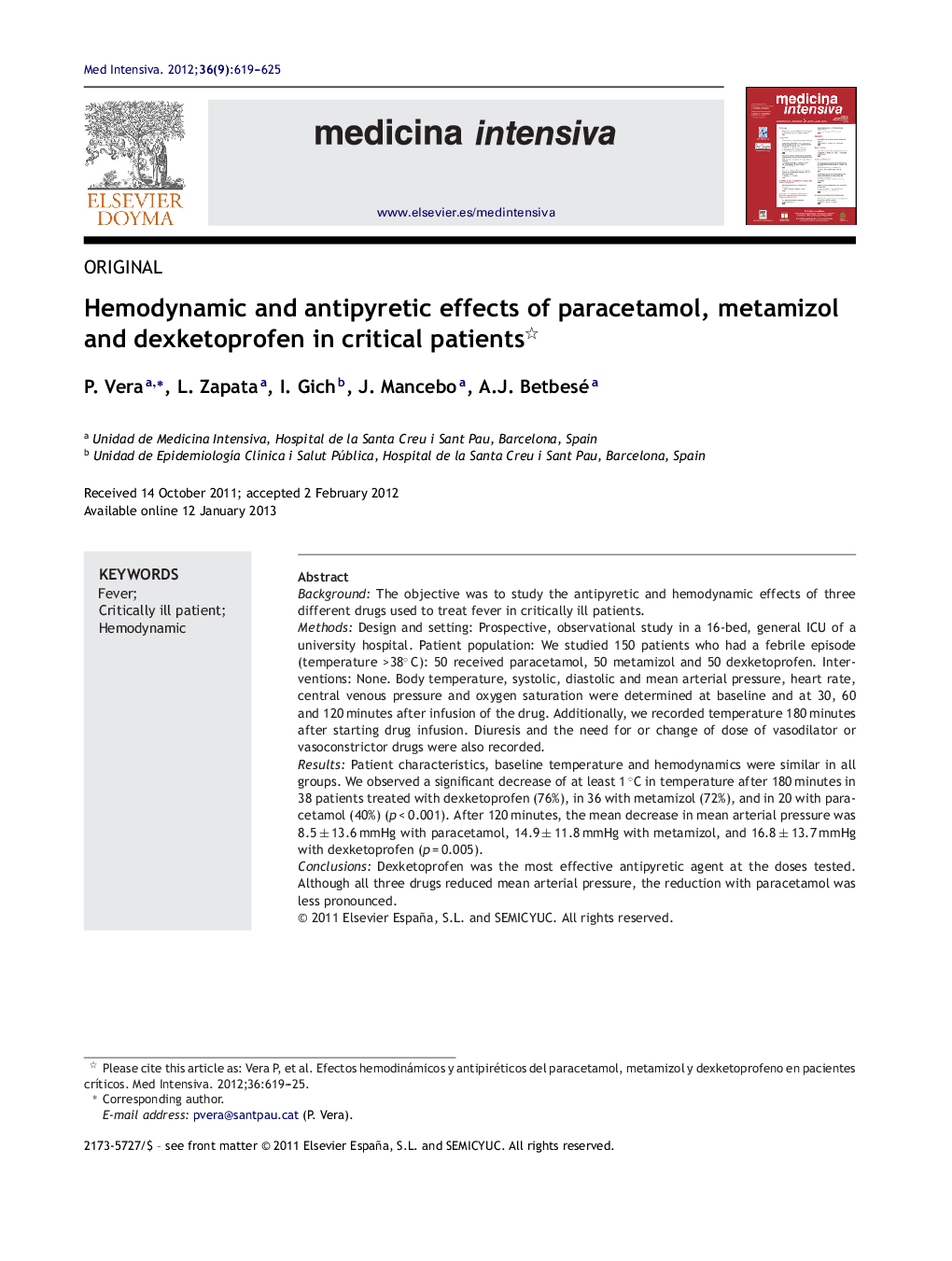| Article ID | Journal | Published Year | Pages | File Type |
|---|---|---|---|---|
| 3114130 | Medicina Intensiva (English Edition) | 2012 | 7 Pages |
BackgroundThe objective was to study the antipyretic and hemodynamic effects of three different drugs used to treat fever in critically ill patients.MethodsDesign and setting: Prospective, observational study in a 16-bed, general ICU of a university hospital. Patient population: We studied 150 patients who had a febrile episode (temperature >38° C): 50 received paracetamol, 50 metamizol and 50 dexketoprofen. Interventions: None. Body temperature, systolic, diastolic and mean arterial pressure, heart rate, central venous pressure and oxygen saturation were determined at baseline and at 30, 60 and 120 minutes after infusion of the drug. Additionally, we recorded temperature 180 minutes after starting drug infusion. Diuresis and the need for or change of dose of vasodilator or vasoconstrictor drugs were also recorded.ResultsPatient characteristics, baseline temperature and hemodynamics were similar in all groups. We observed a significant decrease of at least 1 °C in temperature after 180 minutes in 38 patients treated with dexketoprofen (76%), in 36 with metamizol (72%), and in 20 with paracetamol (40%) (p < 0.001). After 120 minutes, the mean decrease in mean arterial pressure was 8.5 ± 13.6 mmHg with paracetamol, 14.9 ± 11.8 mmHg with metamizol, and 16.8 ± 13.7 mmHg with dexketoprofen (p = 0.005).ConclusionsDexketoprofen was the most effective antipyretic agent at the doses tested. Although all three drugs reduced mean arterial pressure, the reduction with paracetamol was less pronounced.
ResumenObjetivoEl objetivo fue estudiar los efectos antipiréticos y hemodinámicos de 3 fármacos diferentes utilizados para tratar la fiebre en pacientes críticos.Material y métodoDiseño: estudio prospectivo, observacional, en una UCI de 16 camas de un Hospital Universitario. Pacientes: 150 pacientes que tuvieron un episodio febril (temperatura > 38° C). Intervención: 50 recibieron paracetamol, 50 metamizol y 50 dexketoprofeno. Se determinaron la temperatura axilar, presión arterial sistólica, diastólica y media, frecuencia cardíaca, presión venosa central y saturación de oxígeno, en situación basal y a los 30, 60 y 120 minutos tras la administración del fármaco. También se registró la temperatura a los 180 minutos después de haber iniciado el fármaco. La diuresis y las necesidades de tratamiento vasodilatador y vasoconstrictor durante el tratamiento también se registraron.ResultadosLas características de los pacientes, la temperatura y la hemodinámica basal fueron similares en todos los grupos. Observamos un descenso significativo de al menos un grado en la temperatura después de 180 minutos en 38 pacientes tratados con dexketoprofeno (76%), en 36 con metamizol (72%), y en 20 con paracetamol (40%) (p < 0,001). Después de 120 minutos, la media del descenso de la presión arterial media fue de 8,5 ± 13,6 mmHg con paracetamol, 14,9 ± 11,8 mmHg con metamizol y 16,8 ± 13,7 mmHg con dexketoprofeno (p = 0,005).ConclusionesDexketoprofeno fue el fármaco antipirético más efectivo, a las dosis estudiadas. Aunque los 3 fármacos redujeron la tensión arterial media, la reducción con paracetamol fue menos pronunciada.
